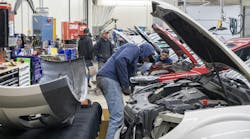When Jeff Hepp first walked into the shop, he was shocked. “Everything was in disarray,” he says. “There was no body shop manager on staff. People were calling and trying to find out where their cars were. Nobody knew what to do. Techs were not happy. They needed new equipment. The shop was filthy. It was an absolute disaster.” Picture the worst-case scenario, and Hepp says that’s what it was like when he was hired as body shop director for Ball Body Shop in Middleton, Wis., seven years ago. Luckily, Hepp has a knack for being a leader on the floor. With over 24 years of experience as both a body shop manager and a technician, he knew that it would take a staff-wide effort to turn a flustered shop into the flourishing company that, today, fixes 240 cars per month and rakes in over $6 million in annual sales. It’s that employee-first philosophy that keeps everyone happy and everything running smoothly at Ball Body Shop.
The shop had been in disarray for quite a few years. We’re part of a dealership and it was driving our owner nuts. He didn't have the time to deal with it. They were in the middle of construction on another building, and then they had to fire the manager and hire me. He’d always had a problem getting the right manager in here. It was through word of mouth that they found me because I’ve got a good history of improving processes at shops.
He just basically told me, “Do what you need to do to get it straightened out.” He did not give me a budget; I had a blank check. I had justifiable reasons for my decisions every step of the way, and that communication was key.
I grabbed a legal pad and a pen, and I pretended to be a fly on the wall. I told everyone, “I’m not here. I'm just observing.” And I basically stood in the corner. I figured I’d do that for about half a day. And after about an hour I'd had enough of what I saw.
So I went to every technician and I asked them what their problems were and what their needs were and what they thought was wrong with the shop. I had a page-and-a-half full of issues they came up with. After the second technician, everybody was pretty much saying the same thing: “We don’t have the right equipment to work on the cars.” “We don’t know which ones we’re supposed to work on next.” “We don't know where the parts are.” “We don't know if the parts have been ordered.” They were very, very frustrated.
I categorized everything, and I started doing the most important things first and worked my way through the whole list. After a month, I had designed our own production system and my own production list that was color-coded and had every vehicle, RO number, who’s working on it, who the painter is, the status of the parts order, expected delivery date, when it came in, how many days the car has been there and how many hours are on the job. It has all that information right in front of them.
We started meeting right away at 8 a.m. with all the technicians and the estimator, the detailers, everybody. And we went over every single car so everybody knew what was going on. After that, it was getting the right equipment. It was nice to have an open checkbook. With my production system, they knew it needed to be done. So they just let me do it.
After figuring out a system that everybody could work well in, we realized the layout in the old shop was bad. The layout of the shop wasn’t even coming close to suiting our needs. We just had a lot of space that wasn’t being utilized properly.
Everything on the floor has to have a purpose, and every square inch is worth the space. We put four paint booths on one side, and then four down-draft, bakeable prep stations in front of them. So we have eight units we can use in the paint shop. Every department has a certain guideline to follow for every single car.
It was just about getting everything organized. I don’t care how big or small you are—if you're well-organized and you don't have parts laying all over the place and everybody knows what's going on and they all have the same goal, things just naturally get done a lot faster. I knew that from previous experience. That's exactly what my goal was: to get it running efficiently as possible.
Technicians and painters always think the office is working against them. It puts a lot of stress on the office and it makes the technicians’ attitudes very negative. So we got everybody involved in the process so they have an understanding of how we write tickets and how we do inspections. There's an answer to every question they have.
The managers and I have open door policies if anybody has issues or ideas to get off their chest. We have to be approachable and make ourselves available at any time.
Once a quarter, we’ll have departmental meetings that I sit in on. Office staff, techs, estimators will get together separately and go over everything. I’ll bring up any issues I have, as well. They communicate what is and isn’t working within their department and explain how to improve with other departments they interact with.
Our retention rate is very high, probably around 80 percent. Very few people have left since I started. It's about the buy-in. They have a say in changes at the shop. If they think something needs to be changed, we’ll try it. We talk about it and we get whoever it affects involved. If it makes sense, we’ll change. We come up with good ideas, and getting staff involved with everything works very well. Once, someone suggested we put blaze-orange notes on the repair order. That way, it is easy to spot and it ensures techs will see the note and the request gets honored. We implemented and still do it to this day.
The key to our success is getting everybody involved. It wasn’t just me standing on the hill, pointing my fingers. Everybody had a say. The technicians let me know what was slowing them down. Everybody pitched in, cleaned it up and organized. It was a team effort. And it still is. Our staff gets it. Everyone we hire knows how we run things. It all starts with the interviewing process. If we are interested in somebody and we really want them to fill that position, we let them know upfront exactly how we do things. We bring them through the shop and show them the process. We let them know that we don’t tolerate the negativity or the rumor spreading. We are too busy for that. We’re pushing 15 to 20 cars out a day. We just let them know up front that it’s a good place to work, it’s not high stress, but we work fast.
When you get a vehicle in your stall with a body tech, it’s ready to get repaired. You don’t have to tear anything down—it’s already done for you. We have one employee dedicated to tearing down cars.
It’s very important you spend the extra time with these people instead of saying, “Oh, OK, you’re I-CAR certified” and throwing them in the mix. It doesn’t work. It’s only fair to them to let them know up front how we work and what the culture is, because if they don’t like it, they have the opportunity to go somewhere else.
I added stuff to the shop to make the technicians more comfortable. There are custom-made mahogany lockers for everybody to use and store their stuff in. We have a huge lavatory that's all tiled and very nice. We have an exhaust evacuation system that’s technicians can use if they’re working on a coolant system. And we air-condition the shop. A lot of it is comfort stuff.
We’re also no-holds barred when it comes to equipment. We try to buy the nicest of the nice. When people take a tour through the shop, they are astounded by this: Every other stall has a machine shop–quality workbench with lights, tools, a credenza—the whole nine yards.
And every drawer can hold over 200 pounds. They literally don't have to bring their toolbox here. It was extremely expensive, but it’s another one of those amenities where it makes sense to do it so there’s not material spread everywhere. They’re held accountable for what they have.
If they feel like they’re part of the process and they have meaning; if they’re reaching for the same goal and it’s not just flat-rate hours and their paycheck; if you can wipe that attitude out just by getting them involved and having the nice stuff? Then you’ve got a winning team.



